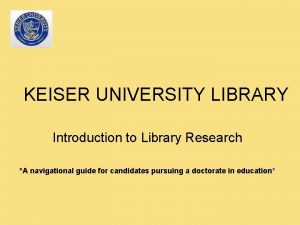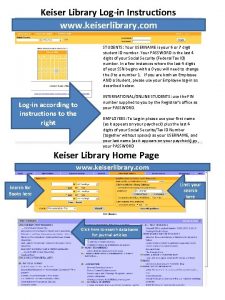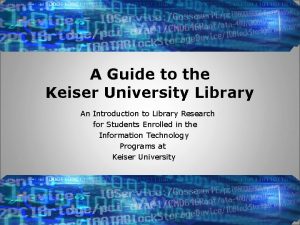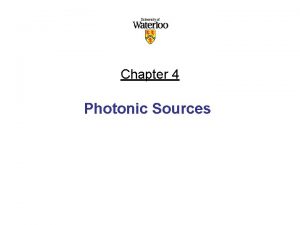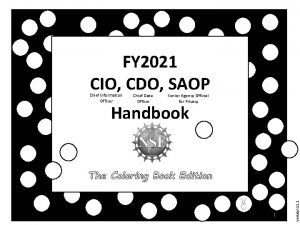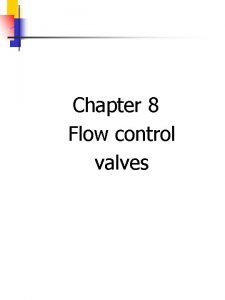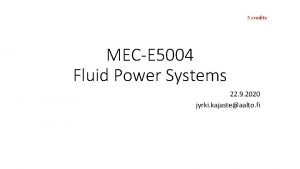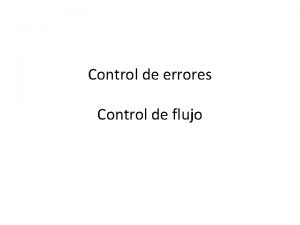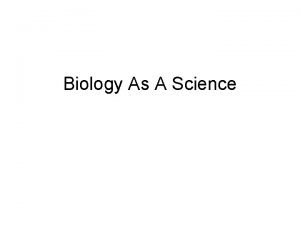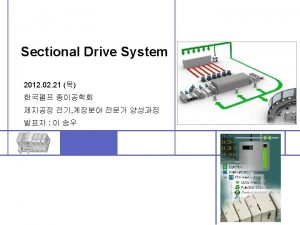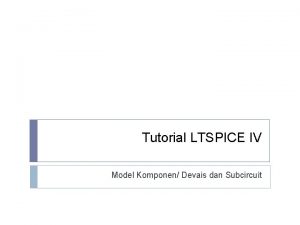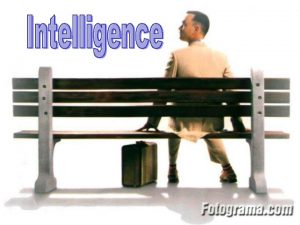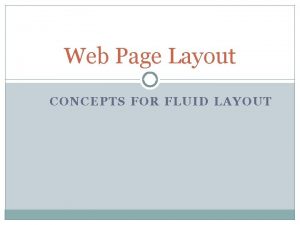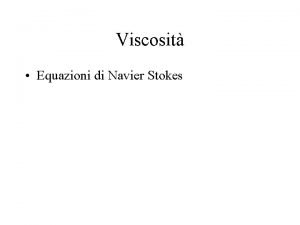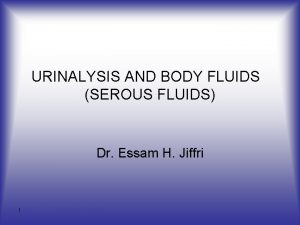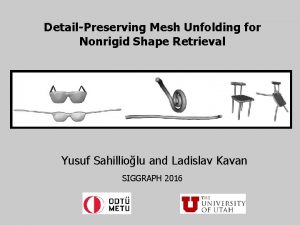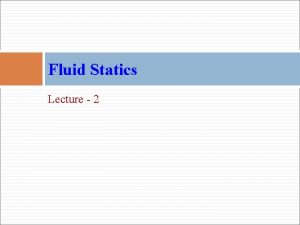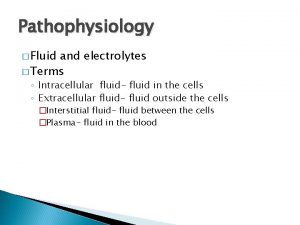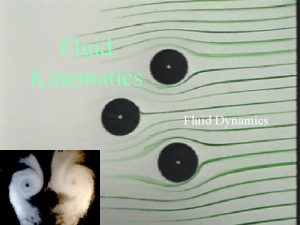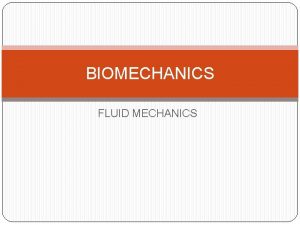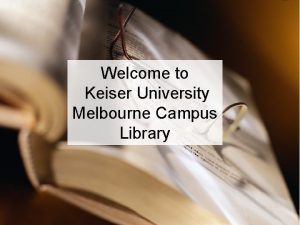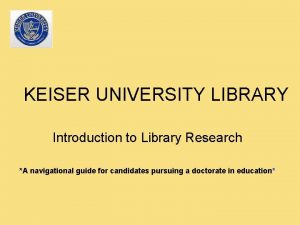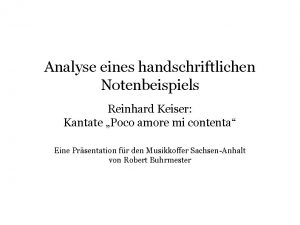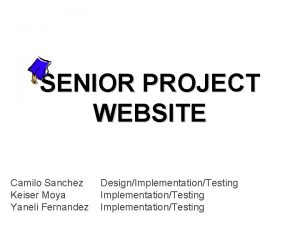DetailPreserving Fluid Control N Threy R Keiser M


![Introduction ◇ Realism of fluids is important [CMT 04] ◇ The fluid controlling for Introduction ◇ Realism of fluids is important [CMT 04] ◇ The fluid controlling for](https://slidetodoc.com/presentation_image_h/1a9cd2087357d475a3eb90df1776fb3a/image-3.jpg)



![Related Work ◇ [REN 04] present a method for the directable animation of photorealistic Related Work ◇ [REN 04] present a method for the directable animation of photorealistic](https://slidetodoc.com/presentation_image_h/1a9cd2087357d475a3eb90df1776fb3a/image-7.jpg)
![Related Work ◇ [FL 04] proposed the idea of driving smoke toward target smoke Related Work ◇ [FL 04] proposed the idea of driving smoke toward target smoke](https://slidetodoc.com/presentation_image_h/1a9cd2087357d475a3eb90df1776fb3a/image-8.jpg)
![Related Work ◇ smoke[SY 05 a] and liquids[SY 05 b] matched the level set Related Work ◇ smoke[SY 05 a] and liquids[SY 05 b] matched the level set](https://slidetodoc.com/presentation_image_h/1a9cd2087357d475a3eb90df1776fb3a/image-9.jpg)







![Generating Control Particles ◇ Motion given by precomputed function [FM 97, FF 01] ◇ Generating Control Particles ◇ Motion given by precomputed function [FM 97, FF 01] ◇](https://slidetodoc.com/presentation_image_h/1a9cd2087357d475a3eb90df1776fb3a/image-17.jpg)

















- Slides: 34

Detail-Preserving Fluid Control N. Thűrey R. Keiser M. Pauly U. Rűde SCA 2006

Abstract ◇ A new fluid control technique - Scale-dependent force control - Preserve small-scale fluid detail ◇ Control particles define local force fields - A physical simulation - A sequence of target shapes ◇ A multi-scale decomposition of the velocity field ◇ Small-scale detail is preserved
![Introduction Realism of fluids is important CMT 04 The fluid controlling for Introduction ◇ Realism of fluids is important [CMT 04] ◇ The fluid controlling for](https://slidetodoc.com/presentation_image_h/1a9cd2087357d475a3eb90df1776fb3a/image-3.jpg)
Introduction ◇ Realism of fluids is important [CMT 04] ◇ The fluid controlling for animation is also important [SY 05 b] ◇ Fine-scale detail such as small eddies or drops

Introduction ◇ In previous method, control particles directly influence the fluid velocity field - It can cause noticeable smoothing effects ◇ To avoid this artificial viscosity, - Decompose the velocity field into coarse- and fine scale component - Only apply control forces to the low-frequency part - High-frequency components are largely unaffected - small-scale detail and turbulence are better preserved

Introduction ◇ We achieve this decomposition by smoothing the velocity field using a low-pass filter ◇ Velocity control forces are computed with respect to the smoothed velocity field ◇ Scale-separated fluid control - Much better preserved - More dynamic and realistic looking simulations

Related Work ◇ Our control paradigm is based on the concept of control particle, similar to [FF 01] ◇ Control particles are independent of the underlying fluid model [FF 01] A 3 D Control Curve
![Related Work REN 04 present a method for the directable animation of photorealistic Related Work ◇ [REN 04] present a method for the directable animation of photorealistic](https://slidetodoc.com/presentation_image_h/1a9cd2087357d475a3eb90df1776fb3a/image-7.jpg)
Related Work ◇ [REN 04] present a method for the directable animation of photorealistic liquids using the particle levelset ◇ [TMPS 03] presented an optimization technique to solve for the control parameters
![Related Work FL 04 proposed the idea of driving smoke toward target smoke Related Work ◇ [FL 04] proposed the idea of driving smoke toward target smoke](https://slidetodoc.com/presentation_image_h/1a9cd2087357d475a3eb90df1776fb3a/image-8.jpg)
Related Work ◇ [FL 04] proposed the idea of driving smoke toward target smoke density ◇ [HK 04] derive potential fields from the initial distribution of smoke and target shape
![Related Work smokeSY 05 a and liquidsSY 05 b matched the level set Related Work ◇ smoke[SY 05 a] and liquids[SY 05 b] matched the level set](https://slidetodoc.com/presentation_image_h/1a9cd2087357d475a3eb90df1776fb3a/image-9.jpg)
Related Work ◇ smoke[SY 05 a] and liquids[SY 05 b] matched the level set surface of the fluid with static or moving target shape

Fluid Simulation Models ◇ We use two fluid simulation models to demonstrate our control method ◇ Smoothed Particle Hydrodynamics (SPH) ◇ The Lattice-Boltzmann Method (LBM)

Smoothed Particle Hydrodynamics (SPH) ◇ As(r) : interpolation value at location r by a weighted sum of contributions from all particles ◇ j : iterates over all particles, mj : the mass of particle j ◇ rj : its postion, ρj : density of particle j ◇ Aj : the field quantity at rj ◇ W(r, h) : smoothing kernel with radius h

Smoothed Particle Hydrodynamics (SPH) ◇ Numerically solving the Navier-Stokes equations

The Lattice-Boltzmann Method (LBM) ◇ A grid based method ◇ Each grid cell stores a set of distribution functions ◇ The common three-dimensional LBM model D 3 Q 19

The Lattice-Boltzmann Method (LBM) Streaming ◇ Streaming Collision Relaxation

The Lattice-Boltzmann Method (LBM) ei : nineteen grid velocitys(0~18) wi : w 0=1/3, w 1. . 6=1/18, w 7. . 18=1/36 : physical fluid viscosity

Fluid Control ◇ Generating Control Particles ◇ Controlling fluid using attraction force and velocity force ◇ Detail-Preserving Control
![Generating Control Particles Motion given by precomputed function FM 97 FF 01 Generating Control Particles ◇ Motion given by precomputed function [FM 97, FF 01] ◇](https://slidetodoc.com/presentation_image_h/1a9cd2087357d475a3eb90df1776fb3a/image-17.jpg)
Generating Control Particles ◇ Motion given by precomputed function [FM 97, FF 01] ◇ Shape given by a Mesh [JSW 05] ◇ Motion from another fluid simulation - using SPH, LBM - very coarse simulation - The simulation may even run in realtime to animator

Control Forces ◇ Attraction force : Force that pulls fluid towards the control particles ◇ Velocity Force : modifying the velocity of the fluid according to the flow determined by the control particles ◇ Control Particle Variables - pi : position of control particle - vi : velocity of control particle - hi : influence radius (2. 5 times the average distance)

Attraction Force ◇ This force is scaled down when the influence region of the control particle is already covered with fluid ◇ Scale factor for attraction force

Attraction Force ◇ Attraction force on a fluid element e ◇ : global contant that defines the strength of the attraction force ◇ if is negative, it will result in a repulsive force

Velocity Force ◇ Velocity Force on a fluid element e ◇ v(e) : the velocity of the fluid element e ◇ : a constant that defines the influence of the velocity force

Total Force ◇ Total control force fc(e) = fa(e) + fv(e) ◇ The new total force per volume f(e) = fc(e) + ff(e) ◇ ff(e) : the fluid force from the physical fluid simulation

Detail-Preserving Control ◇ The velocity force lead to an averaging of the fluid velocities ◇ Undesirable artificial viscosity ◇ We want the natural smallscale fluid motion

Detail-Preserving Control

Detail-Preserving Control

Detail-Preserving Control ◇ Smoothed velocity field ◇ This smoothed version of the fluid velocity replaces V(e) in Equation 7

Detail-Preserving Control ◇ ◇ is low pass filtered velocity is high pass filtered velocity ◇ vp is the interpolated velocity of the control particles at a fluid element e

Results and Discussion ◇ We have implemented our control algorithm for both an SPH and an LBM fluid solver ◇ Within the SPH solver, the existing acceleration structures can be used to query fluid particles in the neighborhood of a control particle ◇ For the LBM solver, control particles are rasterized to the grid

Results and Discussion ◇ The simulation using LBM with a grid resolution took 142 s per frame, including 4 s for computing the control force ◇ These control particles are blended with 5 k control particles sampled from the 3 D model of the human figure

Results and Discussion ◇ The control flow with detailpreservation retains small-scale fluid features ◇ The simulation was done using LBM with a 240*120 grid resolution which took 38 s per frame on average ◇ The computation of the control forces took 2 -4% of the total computation time

Results and Discussion ◇ The mesh is only used to generate a sequence of control particles as described in Section 3. 1 ◇ We used 266 k particles for the SPH simulation which took 102 s per frame including the computation of the control forces which took 14 s

Results and Discussion ◇ Our detail-preserving approach clearly reduces the artificial viscosity by the control forces ◇ The user can interactively adjust the parameters until the desired coarse-scale behavior of the fluid is obtained ◇ Our framework could also be used to control the deformation of elastic bodies

Conclusions ◇ A detail-preserving approach for controlling fluids based on control particles ◇ We solve the problem of artificial viscosity introduced by the control forces by applying these forces on the lowpass filtered velocity field ◇ Only the coarse scale flow of the fluid is modified while the natural small-scale detail is preserved, resulting in more natural looking controlled simulations

References
 Synovial fluid
Synovial fluid P1-p2
P1-p2 Fluid statics deals with
Fluid statics deals with Total body water
Total body water Interstitial fluid vs extracellular fluid
Interstitial fluid vs extracellular fluid Interstitial vs intracellular
Interstitial vs intracellular Boundary layer theory
Boundary layer theory Extracellular fluid and interstitial fluid
Extracellular fluid and interstitial fluid Horseshoe dullness in ascites
Horseshoe dullness in ascites Keiser student portal
Keiser student portal Keiser university library login
Keiser university library login Www.keiserlibrary.com
Www.keiserlibrary.com Keiseruniversity library
Keiseruniversity library Keiser university dietetic internship
Keiser university dietetic internship Keiser
Keiser Rebecca keiser nsf
Rebecca keiser nsf Fluid flow control valve
Fluid flow control valve Fluid power system
Fluid power system Translational research institute on pain in later life
Translational research institute on pain in later life Dairy plant management
Dairy plant management Fluids mechanics
Fluids mechanics Stock control e flow control
Stock control e flow control Control volume vs control surface
Control volume vs control surface Operon positive and negative control
Operon positive and negative control Positive control vs negative control
Positive control vs negative control Data link control
Data link control Control de flujo parada y espera
Control de flujo parada y espera Negative control vs positive control examples
Negative control vs positive control examples Error control and flow control
Error control and flow control Sectional drive
Sectional drive Control c control v
Control c control v Difference between crystalized and fluid intelligence
Difference between crystalized and fluid intelligence Liquid layout website
Liquid layout website Sprittles
Sprittles Serous fluid
Serous fluid










